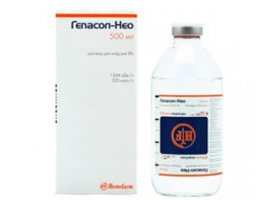
All iLive content is medically reviewed or fact checked to ensure as much factual accuracy as possible.
We have strict sourcing guidelines and only link to reputable media sites, academic research institutions and, whenever possible, medically peer reviewed studies. Note that the numbers in parentheses ([1], [2], etc.) are clickable links to these studies.
If you feel that any of our content is inaccurate, out-of-date, or otherwise questionable, please select it and press Ctrl + Enter.
Hepasol neo 8%
Medical expert of the article
Last reviewed: 04.07.2025

Hepasol Neo 8% is an infusion fluid used for parenteral nutrition procedures; it contains a complex of various amino acids.
During metabolic processes, amino acids synthesize ammonium ions, which have a powerful toxic effect and also help to remove them. The drug significantly potentiates detoxifying liver activity and also prevents damage to ammonia tissues inside the central and peripheral nervous systems in people with liver dysfunction.
ATC classification
Active ingredients
Pharmacological group
Pharmachologic effect
Indications Hepasol neo 8%
The substance is used to provide the body with amino acids by parenteral administration. It is prescribed in cases of severe liver failure (with or without encephalopathy ), when enteral or oral nutrition is prohibited, insufficient or impossible.
Release form
The medicinal substance is released in the form of an infusion liquid, inside 0.5 l bottles.
Pharmacokinetics
The bioavailability level of all amino acids contained in the liquid is 100%.
When administered parenterally, the introduced amino acids are distributed and undergo metabolic processes within all tissues of the body; they participate in protein binding, as well as in processes of providing the body with energy. Those amino acids that have not been used by the cells undergo deamination with the formation of urea.
Excretion occurs via the kidneys in the form of metabolic elements. In the case of parenteral administration at high speed, some of the amino acids are excreted unchanged.
Dosing and administration
The medicine can only be used in hospitals and only by adults.
The medication should be administered intravenously – into the central and peripheral veins. The doses used are 1.0-1.25 ml/kg per hour, which is equal to 0.08-0.1 g/kg of amino acids per 1 hour. The infusion rate may not exceed 1.25 ml/kg per 60 minutes, which is equal to 0.1 g/kg of amino acids per 60 minutes. A maximum of 1.5 g/kg of amino acids is allowed per day, which is equal to 18.75 ml/kg and equivalent to 1.3 liters for a person with an average weight of 70 kg.
With parenteral nutrition, the substance is usually administered in combination with liquids that satisfy the energy requirement (fat emulsions with carbohydrates), as well as the need for vitamins, electrolytes and microelements.
The duration of drug use is determined by the clinical picture. The medication should be used until amino acid metabolism processes are stabilized.
Use Hepasol neo 8% during pregnancy
No safety testing has been performed for Hepasol Neo 8% during pregnancy or breastfeeding. Clinical data do not contain information with a proven risk of adverse effects during these periods. If the medication is prescribed during these periods, it is necessary to carefully assess the benefits and risks of its use.
Contraindications
Main contraindications:
- severe intolerance associated with the elements of the drug;
- disorder of amino acid metabolism processes;
- hyperhydria;
- hypokalemia or -natremia;
- renal failure;
- Heart failure in the decompensated stage;
- hypoxia or shock;
- metabolic acidosis;
- pulmonary edema in the active phase.
Side effects Hepasol neo 8%
If the drug is administered into peripheral veins, thrombophlebitis may develop.
When the medication is used correctly, side effects usually do not develop.
When using products containing amino acids, headaches, symptoms of severe sensitivity and manifestations in the injection area sometimes occur.
Overdose
When used correctly, Hepasol NEO 8% has a very low risk of poisoning. If infused too quickly into the peripheral veins, thrombophlebitis may occur (adequate osmolarity must be selected). People with previously caused liver dysfunction may experience vomiting, proteinuria, nausea, and fever.
If symptoms of intoxication develop, the infusion must be stopped immediately.
Interactions with other drugs
Amino acid liquid should not be mixed with other solutions (except for substances for parenteral nutrition), because there is a possibility of incompatibility or microbiological mixing.
Combination with other parenterally administered nutritional components is permitted if their compatibility is confirmed.
Storage conditions
Gepasol Neo 8% should be stored in a dark place, out of the reach of small children. Temperature indicators should not exceed 30°C.
Shelf life
Hepasol Neo 8% can be used within a 2-year period from the date of manufacture of the medicinal product.
Application for children
The drug is prohibited for use in pediatrics.
Analogues
The analogs of the drug are Aminoven Infant 10%, Nephrotect with Aminoplasmal 10% E, and Aminosteril-N-Gepa.
Manufacturer
Attention!
To simplify the perception of information, this instruction for use of the drug "Hepasol neo 8%" translated and presented in a special form on the basis of the official instructions for medical use of the drug. Before use read the annotation that came directly to medicines.
Description provided for informational purposes and is not a guide to self-healing. The need for this drug, the purpose of the treatment regimen, methods and dose of the drug is determined solely by the attending physician. Self-medication is dangerous for your health.

